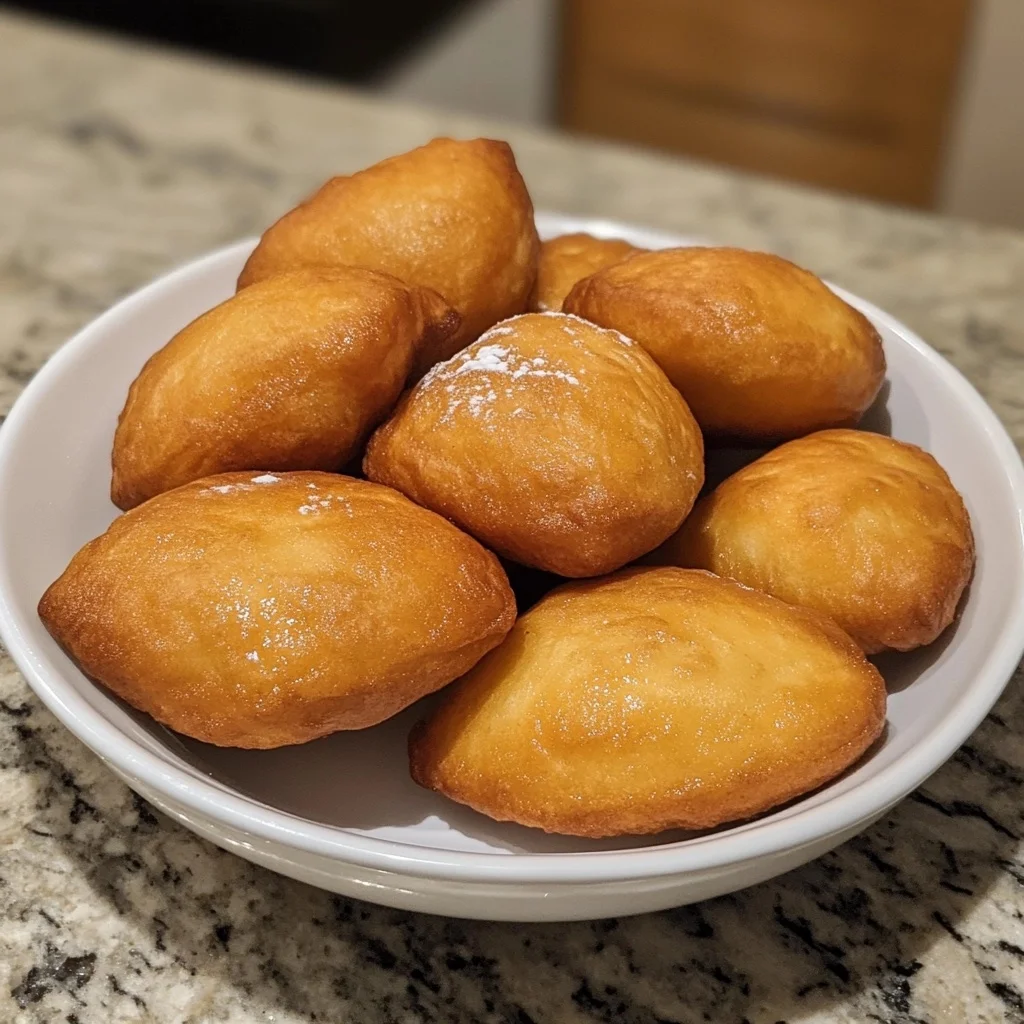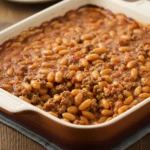Haitian beignets offer a delightful taste of the Caribbean, bringing a touch of sweetness and a burst of flavor to your palate. These delectable treats, similar to the French beignet but with a unique twist, are a staple in Haitian cuisine. Perfect for any occasion, Haitian beignets are easy to make and even easier to enjoy. In this article, we’ll explore how to create these delicious pastries, step by step, while highlighting the cultural significance and joy they bring to any table.
Ingredients
Creating the perfect Haitian beignet begins with gathering the right ingredients. Here’s what you’ll need:
- 2 cups all-purpose flour
- 1/4 cup sugar
- 1/2 tsp salt
- 1 tbsp baking powder
- 1/2 tsp cinnamon (optional)
- 1/2 cup milk (or non-dairy milk)
- 1 large egg
- 2 tbsp melted butter (or coconut oil)
- Oil for frying
- Powdered sugar for dusting
These simple ingredients come together to create a delicious treat that is rich in flavor and texture. Each component contributes to the beignet’s fluffy interior and crispy exterior, making them irresistible.
Instructions
Making Haitian beignets is a straightforward process that yields delightful results. Follow these steps to create your own batch of these sweet pastries:
- Mix the Dry Ingredients
In a bowl, combine the all-purpose flour, sugar, salt, baking powder, and cinnamon. Ensure they are thoroughly mixed to create a consistent base for your batter. - Prepare the Wet Ingredients
In another bowl, whisk together the milk, egg, and melted butter. Whisk until the mixture is smooth and the egg is fully incorporated. - Combine Wet and Dry Ingredients
Gradually combine the wet and dry ingredients, mixing until just combined. Avoid overmixing to ensure the beignets remain light and airy. - Heat the Oil
In a deep pan, heat oil over medium-high heat. The oil should be hot enough to fry the beignets without burning them. - Fry the Beignets
Drop spoonfuls of batter into the hot oil. Fry each beignet until golden brown, approximately 2-3 minutes per side. Ensure they are cooked through without being doughy in the center. - Drain and Dust
Remove the beignets from the oil and drain them on paper towels. Dust generously with powdered sugar before serving to add a touch of sweetness.
Nutrition Facts
Understanding the nutritional content of your food is essential. Here’s a breakdown of the nutritional values per Haitian beignet:
- Calories: 120
- Protein: 2g
- Fat: 6g
- Carbohydrates: 15g
- Sugar: 4g
These values make Haitian beignets a delightful indulgence, perfect for a sweet treat without overindulging.
How to Serve
Haitian beignets are not only a delightful treat but also an incredibly versatile dish that can be enjoyed in numerous ways depending on the occasion and personal preference. Their light, fluffy texture and subtly sweet flavor make them an excellent choice for various meals and settings. Here’s a closer look at some of the best ways to serve and enjoy these delectable pastries:
Breakfast Delight
Start your day on a high note by pairing Haitian beignets with your favorite morning beverage. The light sweetness of the beignets complements the rich and bold flavors of coffee or the gentle warmth of tea. For an authentic experience, consider serving them with a cup of Haitian coffee, known for its strong, robust flavor, often enjoyed with a sprinkle of cinnamon or nutmeg. You can also drizzle a bit of honey or maple syrup over the beignets for added sweetness, making them an indulgent breakfast option that’s sure to energize your morning.
Dessert Option
Haitian beignets can easily transition into a delightful dessert. For an impressive presentation, serve them warm alongside a scoop of vanilla or coconut ice cream, allowing the warmth of the beignets to slightly melt the ice cream, creating a deliciously creamy contrast. Alternatively, consider pairing them with fresh fruit like strawberries, mango, or pineapple, which can add a refreshing acidity that balances the sweetness of the beignets. A dusting of powdered sugar or a drizzle of chocolate or caramel sauce can elevate this dessert, making it a stunning centerpiece for any dinner party or gathering.
Snack Time
When it comes to snacking, Haitian beignets are an excellent choice for any time of the day. Their light and fluffy nature makes them perfect for a midday pick-me-up. Pair them with a refreshing beverage, such as iced tea, lemonade, or even a fruit smoothie, to create a satisfying snack that can help rejuvenate your afternoon. You can also fill beignets with sweet or savory fillings, such as cream cheese, fruit preserves, or even cheese, to add variety and cater to different taste preferences. This versatility ensures that they can be enjoyed at any time, whether you’re looking for something sweet to satisfy your cravings or a savory bite to tide you over until dinner.
Perfect for Gatherings
The crowd-pleasing nature of Haitian beignets makes them an ideal addition to any gathering. Whether it’s a casual brunch, a festive celebration, or a family reunion, the beignets can be served in various forms to suit the occasion. Consider setting up a beignet bar where guests can customize their treats with an array of toppings, such as powdered sugar, flavored syrups, fresh fruit, or whipped cream. This interactive element not only enhances the experience but also allows everyone to tailor their beignet to their taste, making it a memorable part of the event.
Cultural Touch
Incorporating Haitian beignets into your meal planning also allows you to celebrate and share Haitian culture with your family and friends. These pastries hold a significant place in Haitian cuisine, often enjoyed during holidays and special occasions. By serving them, you not only delight your guests’ taste buds but also provide them with a glimpse into the rich culinary traditions of Haiti.
In summary, Haitian beignets are a versatile and delightful treat that can be served in many ways, whether as a sweet breakfast, an elegant dessert, or a satisfying snack. Their adaptability makes them a perfect choice for any occasion, ensuring they are always a hit with family and friends. So, whether you’re enjoying them solo or sharing them with loved ones, Haitian beignets are sure to bring joy and flavor to your table.ering.
Additional Tips
Creating the perfect Haitian beignets is an art that requires attention to detail and a few insider tips to elevate your culinary experience. Below are some comprehensive guidelines to ensure that your beignets turn out deliciously every time you make them.
Temperature Control
Maintaining a consistent oil temperature is crucial for achieving the ideal beignet texture. If the oil is too hot, the beignets will brown quickly on the outside while remaining raw inside. Conversely, if the oil is too cool, the beignets will absorb excess oil, resulting in a greasy product.
- Use a Thermometer: Invest in a cooking thermometer to monitor the oil temperature accurately. The ideal frying temperature for beignets is between 350°F and 375°F (175°C to 190°C).
- Test the Oil: Before frying a full batch, drop a small spoonful of batter into the oil. If it sizzles and rises to the surface, the oil is ready. If it sinks, the oil is too cool; if it browns too quickly, it’s too hot.
- Adjust as Needed: Be prepared to adjust the heat throughout the frying process, as the temperature can drop when multiple beignets are added to the pot.
Batter Consistency
The consistency of your batter is another key factor in making perfect beignets.
- Right Thickness: The batter should be thick enough to hold its shape when dropped into the oil. It should not be so thick that it becomes dense and heavy; instead, it should have a light and fluffy quality. A good test is to use a spoon: the batter should fall off in a smooth, continuous ribbon.
- Avoid Overmixing: When combining your ingredients, mix just until incorporated. Overmixing can lead to tough beignets due to gluten development. A few lumps in the batter are perfectly fine.
Flavor Variations
While traditional Haitian beignets are delightful on their own, you can enhance their flavor in various ways.
- Add Vanilla Extract: A teaspoon of vanilla extract can add a warm, aromatic touch that complements the sweetness of the beignets.
- Experiment with Spices: Consider incorporating spices like nutmeg or cinnamon for an extra layer of flavor. Start with a quarter teaspoon and adjust to your taste.
- Citrus Zest: Adding a bit of lemon or orange zest can infuse a refreshing brightness that pairs beautifully with the sweetness of the beignets.
Storage
Proper storage is essential to preserve the texture and flavor of leftover beignets.
- Cooling: Allow beignets to cool completely on a wire rack after frying. This helps prevent moisture from building up, which can make them soggy.
- Airtight Container: Store them in an airtight container at room temperature. If you live in a humid environment, consider refrigerating them to extend their freshness.
- Reheating: To regain their crispiness, reheat the beignets in an oven preheated to 350°F (175°C) for about 5-10 minutes, or until they are warmed through and crispy again. Avoid microwaving them, as this can make them chewy and lose their delightful texture.
Additional Tips for Serving
- Dusting with Sugar: Just before serving, dust your beignets with powdered sugar for a classic touch. This not only enhances the visual appeal but also adds a delightful sweetness.
- Serving Suggestions: Consider pairing your beignets with a dipping sauce, such as chocolate or fruit preserves, to elevate the taste experience further.
By following these additional tips, you can achieve the perfect texture and flavor in your Haitian beignets every time you make them. Happy frying!
FAQs
Q: Can I use a different type of flour?
A: Absolutely! While all-purpose flour is the most common choice for making beignets due to its balanced protein content, you can certainly experiment with other types of flour. Whole wheat flour is a popular alternative that adds a nutty flavor and increases the fiber content, making your beignets a bit denser and heartier. However, it’s important to note that this change in flour may affect the overall texture of the beignets; they might not be as light and airy as those made with all-purpose flour. If you are opting for gluten-free flour, consider using a blend designed for baking, which often contains a mix of rice flour, potato starch, and xanthan gum. This can help mimic the elasticity and structure of gluten, but keep in mind that the taste and texture may still differ slightly from traditional beignets. Always be prepared for some trial and error when substituting flours, as each type behaves differently in the frying process.
Q: What type of oil is best for frying?
A: When it comes to frying beignets, choosing the right oil is crucial for achieving that perfect golden-brown crust. A neutral oil with a high smoke point is recommended, which allows you to fry at the optimal temperature without the oil burning or imparting unwanted flavors to your beignets. Canola oil and vegetable oil are excellent options, as they both have smoke points around 400°F (204°C), making them ideal for frying. Other acceptable choices include peanut oil and sunflower oil, which also have high smoke points and neutral flavors. If you’re looking for a bit of flavor, you can consider using oils like coconut oil or avocado oil; however, keep in mind that these oils have distinct tastes that may alter the final result. Regardless of your choice, be sure to maintain the oil temperature during frying, adjusting the heat as necessary to avoid soggy or greasy beignets.
Q: Can I make the batter ahead of time?
A: While the temptation to prepare the batter in advance might save time, it’s highly recommended to prepare the batter fresh for optimal results. When batter sits, particularly when it contains yeast, it can lose its aeration, leading to denser beignets that lack the signature fluffy texture. Freshly made batter allows the yeast to work its magic, creating air pockets that contribute to a light, airy consistency. If you absolutely must prepare the batter ahead of time, consider refrigerating it and allowing it to come to room temperature before frying. However, keep in mind that the texture may still not match that of freshly made batter. For the best taste and texture, plan to whip up the batter just before you’re ready to fry.
Q: How can I tell if the oil is hot enough?
A: Ensuring your oil is at the right temperature is vital for frying beignets to perfection. If the oil is too cold, the beignets will absorb excess oil, becoming greasy rather than light and crisp. Conversely, if the oil is too hot, the outside may brown too quickly while the inside remains raw. A simple test to check the oil’s readiness is to drop a small amount of batter into the oil. If it sizzles immediately and floats to the surface, the oil is at the right temperature for frying, typically around 350°F to 375°F (175°C to 190°C). Another method is to use a thermometer to monitor the oil temperature accurately, ensuring consistent frying results. If you don’t have a thermometer, you can also use a wooden spoon; dipping the handle into the oil should produce small bubbles around it, indicating that the oil is hot enough. Always fry in small batches to maintain the oil temperature and achieve evenly cooked beignets.
Conclusion
Haitian beignets are more than just a sweet treat; they are a celebration of culture and flavor. Their simplicity and deliciousness make them a beloved choice for any occasion. By following this guide, you can bring a taste of the Caribbean into your home and enjoy the rich flavors and textures that Haitian beignets offer. Whether you’re sharing them with friends and family or indulging in a solo treat, these pastries are sure to delight and satisfy. Enjoy your culinary journey with Haitian beignets, and let each bite transport you to the vibrant world of Haitian cuisine.





